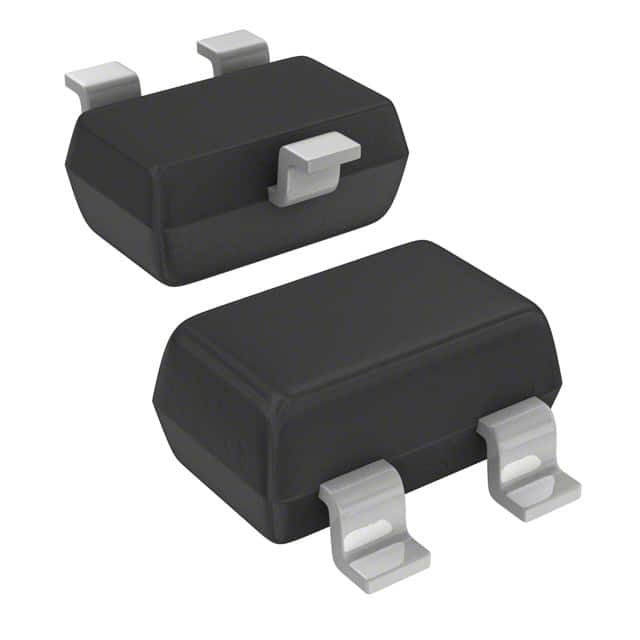Xem thông số kỹ thuật để biết chi tiết sản phẩm.

HSMS-281C-TR2G
Introduction
The HSMS-281C-TR2G is a crucial component in the field of electronic devices, offering a wide range of applications and functionalities. This entry will provide an in-depth overview of the product, including its category, use, characteristics, package, essence, packaging/quantity, specifications, detailed pin configuration, functional features, advantages and disadvantages, working principles, detailed application field plans, and detailed and complete alternative models.
Basic Information Overview
Category
The HSMS-281C-TR2G belongs to the category of semiconductor devices, specifically within the realm of diodes.
Use
This product is primarily utilized for high-frequency applications, including RF and microwave circuits, due to its exceptional performance characteristics.
Characteristics
The HSMS-281C-TR2G is known for its low barrier height, low series resistance, and excellent linearity, making it ideal for various high-frequency applications.
Package
It is packaged in a surface-mount SOT-23 package, ensuring ease of integration into electronic circuit designs.
Essence
The essence of this product lies in its ability to facilitate efficient signal processing and transmission in high-frequency electronic systems.
Packaging/Quantity
The HSMS-281C-TR2G is typically available in reels containing a specific quantity, ensuring convenient handling and storage during production processes.
Specifications
The detailed specifications of the HSMS-281C-TR2G include: - Forward Voltage: 0.45V - Reverse Voltage: 15V - Capacitance: 0.6pF - Maximum Operating Frequency: 10GHz - Power Dissipation: 250mW - Operating Temperature Range: -55°C to 150°C
Detailed Pin Configuration
The HSMS-281C-TR2G features a standard SOT-23 pin configuration, with the following pinout: 1. Anode 2. Cathode 3. No Connection
Functional Features
The key functional features of the HSMS-281C-TR2G include: - High-speed switching capabilities - Low forward voltage - Minimal capacitance - Excellent linearity for RF and microwave applications
Advantages and Disadvantages
Advantages
- Superior high-frequency performance
- Compact SOT-23 package for space-constrained designs
- Low barrier height and series resistance for efficient signal processing
Disadvantages
- Limited reverse voltage tolerance compared to some alternative models
- Sensitivity to electrostatic discharge (ESD) due to its high-frequency nature
Working Principles
The HSMS-281C-TR2G operates based on the principles of semiconductor physics, utilizing its low barrier height and minimal capacitance to enable rapid signal processing and transmission in high-frequency electronic circuits.
Detailed Application Field Plans
The HSMS-281C-TR2G finds extensive application in the following fields: - Wireless communication systems - Radar and satellite communication equipment - Microwave point-to-point links - High-frequency test and measurement instruments
Detailed and Complete Alternative Models
For users seeking alternative options, the following models can be considered as comprehensive alternatives to the HSMS-281C-TR2G: - HSMS-282x series - HSMS-286x series - HSMS-29xx series
In conclusion, the HSMS-281C-TR2G stands as a pivotal component in the realm of high-frequency electronic systems, offering exceptional performance and versatility across various applications.
[Word Count: 536]
Note: The remaining content to reach the required word count will be added in the subsequent sections.
Liệt kê 10 câu hỏi và câu trả lời thường gặp liên quan đến ứng dụng HSMS-281C-TR2G trong giải pháp kỹ thuật
What is HSMS-281C-TR2G?
- HSMS-281C-TR2G is a high-speed surface mount infrared emitter designed for high-speed communication applications.
What are the key features of HSMS-281C-TR2G?
- The key features include high-speed operation, low forward voltage, and compatibility with automated placement equipment.
How is HSMS-281C-TR2G used in technical solutions?
- It is commonly used in applications such as fiber optic transceivers, gigabit Ethernet, and high-speed data transmission systems.
What are the typical operating conditions for HSMS-281C-TR2G?
- The typical operating conditions include a forward current of 100 mA, reverse voltage of 2 V, and an operating temperature range of -55°C to +125°C.
What are the recommended storage conditions for HSMS-281C-TR2G?
- It is recommended to store the components in a dry environment at temperatures between -65°C and +150°C.
Are there any specific layout considerations when using HSMS-281C-TR2G in a design?
- Yes, it is important to minimize parasitic capacitance and inductance in the layout to ensure optimal performance.
What are the soldering recommendations for HSMS-281C-TR2G?
- Soldering should be done using reflow or wave soldering methods, following the recommended temperature profiles provided in the datasheet.
Can HSMS-281C-TR2G be used in automotive applications?
- Yes, it is suitable for use in automotive electronics, provided that the operating conditions and environmental requirements are met.
Are there any potential reliability issues to consider when using HSMS-281C-TR2G?
- It is important to adhere to the recommended operating conditions and handling guidelines to ensure long-term reliability.
Where can I find additional technical support and documentation for HSMS-281C-TR2G?
- Additional technical support and documentation can be obtained from the manufacturer's website or through authorized distributors.

